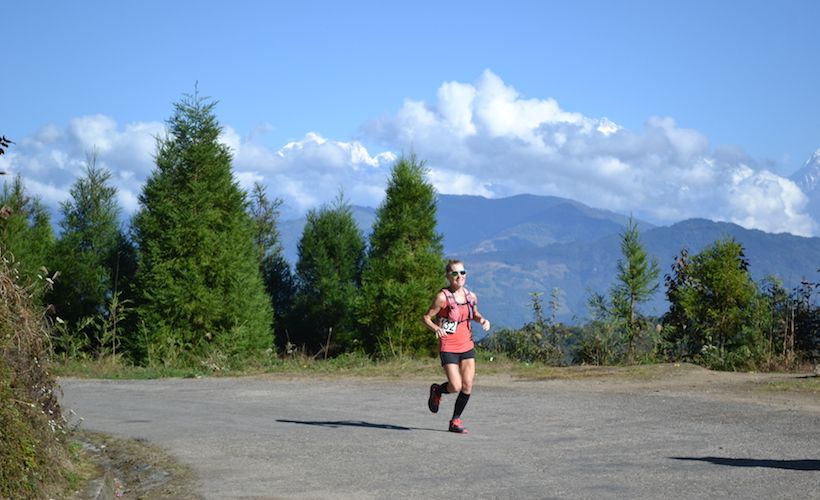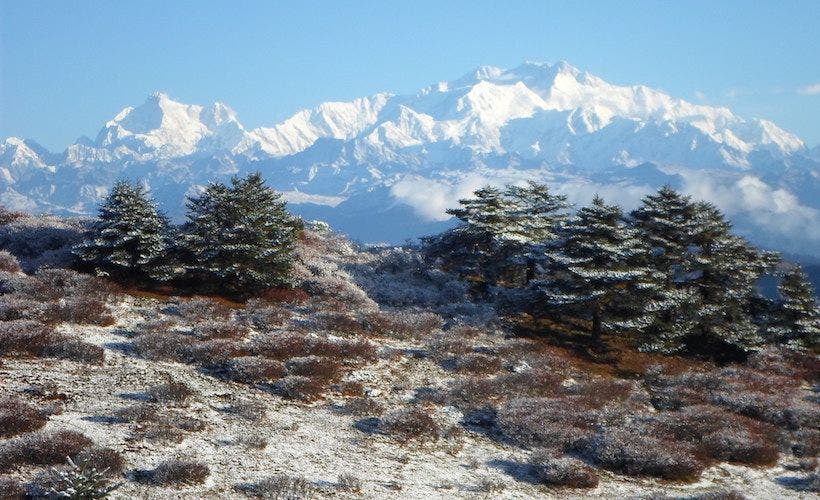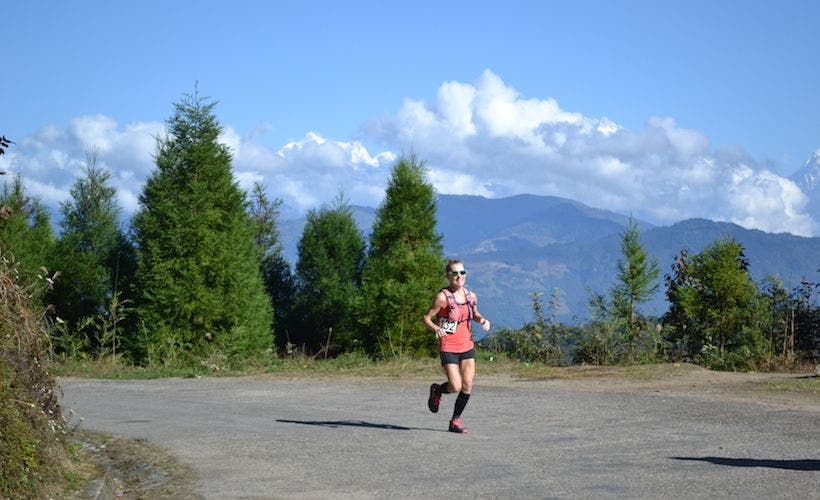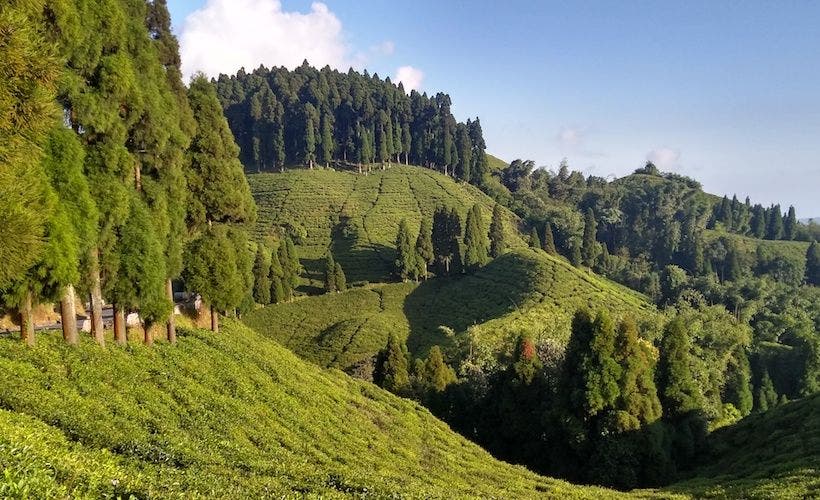Running 100 Miles Through The Himalaya

Sleepless Anticipation
I am awake in the dark long before my 4:30 a.m. alarm goes off. This is in part because I’ve spent the last few hours listening to a furious, unremitting gnawing from somewhere in a dark corner of my room but whose source eludes my flashlight each time I switch it on. The main reason I’m awake, though, is a restless feeling of excitement mixed with a lot of hope. Today is the day we have our best chance to view Mount Everest, though the foggy, sleety, socked-in weather the day prior has made this seem very unlikely. This is a worry. Everest is at least in part why I’ve come here.
“Here,” to be precise, is Sandakphu (elevation 12,000 feet), in remote northeast India, on Day 3 of the Himalayan Run & Trek, a 100-mile, five-day stage race.
Two days of hard running have brought me and 58 other participants to this remote hill station in the shadow of the Himalaya. The inn we’re staying at is rough, but I like its simplicity. I find it to be perfectly suited to the harsh, mountainous terrain that surrounds it. Participants are bunked five to a room, the food is basic—soup, rice, porridge—and we eat it standing up, crowded together in a decidedly unglamorous cement-floored room. The quarters are close, but at least they keep us warm when temperatures dip below freezing in the unseasonably stormy weather.
It feels a long way from where the adventure began, more than 11,000 feet lower, in Bagdogra.
I flew in from Denver, through Delhi and on to hot, humid Bagdogra, a low-lying military town in the state of West Bengal. From there, it was a swashbuckling bus ride up steep narrow roads and around hairpin turns to Mirik, a lakeside town surrounded by bright green tiers of tea fields. Here, participants meet, acclimate and prepare for the race ahead.
The weather is much cooler in Mirik than in Bagdogra. I pull a fleece out of my duffel as I stand in the hotel lobby awaiting my room assignment, checking out other participants as they arrive. Everyone is dressed in colorful, puffy jackets and rugged trail shoes like it’s the uniform, lugging duffels, smiling, chattering and making introductions. It feels like the first day of camp. The assistant race director, Mansi, is directing traffic in the lobby and handing out wooden keys the size of doorstops. She pairs me with Sofie, an art director, triathlete and mom of two from Stockholm. We’ll be roommates on the five-day adventure ahead.
We all gather for a pre-race briefing the first evening. I’m surprised by the age range and variety of accents. I learn that this year’s participants come from 11 countries, including Spain, Argentina, Germany, Canada and Australia. Ages range as well, with the youngest a 15-year-old from England who has accompanied his mom and the eldest a 77-year-old nine-time participant from Hong Kong.
Goals range, too. Paul, a 49-year-old businessman from England, says he has come to win, and as a former masters half-marathon world champion and winner of several international races, he has the résumé to do it. But Mariano, a 27-year-old fashion model and personal trainer from Argentina, makes no secret of his plans to challenge that. On the other end of the spectrum, some plan to run easy every day and simply enjoy the views, while others will hike rather than run. The HRT’s unique setup—no cutoff times and provision of buses and “sweep Jeeps” to pick up slower walkers and runners—opens up a range of options, allowing for this wide diversity in goals. Several couples and groups tell me they have come to share the experience, despite not sharing the same interest in running.
The race briefing is run by the vigorous and colorful C.S. Pandey, HRT’s mastermind and director for 27 years. Energetic and impassioned, Pandey uses a podium, pointer and whiteboard to walk us through the route, the intricacies of luggage movements between stages and other sundry race details. He speaks forcefully and with passion, often veering off onto tangents such as clarifying the meaning of Himalaya (it means “House of Snow,” he says, and must always be singular) and discussing his longtime dedication to preserving the culture of remote India. When asked why he started HRT back in 1991, Pandey, who is himself from Central Himalaya, says, “I love these mountains and its people. I wanted to introduce a unique activity to people from all over the world that showcased the Himalaya, its people, the culture, nature and beauty.”
He has a powerful, mystical view of nature, and his enthusiasm is inspiring. It is also reassuring. He admits his surprise about the weather, which this year has been abnormally cold, wet and cloudy, but he says that in 26 years, no stage of the race has ever been cancelled and insists, “If you take care of Nature, she will take care of you.” We’re all hopeful this is true because seeing Everest is on everyone’s mind. On a clear day, it should be easy to spot from our high roost in Sandhakphu.
Which brings me to where I lie now. Early morning, Day 3. I check the time again. Too early to rise. But I’m wide awake now and almost giddy, despite a serious lack of sleep, 44 challenging miles and more than 5,000 feet of elevation gain covered since Day 1. I tug my wool hat farther down on my head and plunge deeper into my sleeping bag, trying not to wake Sofie with my restlessness.
Today is a really big day. If the weather cooperates, we are perfectly poised to view Everest and the Himalayan chain of mountains that includes Kanchenjunga, Lhotse and Makalu—four of the five highest peaks in the world. Today is also big because we will run the Mount Everest Marathon. With 24 miles, and then 20, already under our belt, today’s menu offers 26.2, making today not only the longest, but—given the route’s relentless climbs and descents—the hardest day of the five. I’m already fatigued and sore from the first two days. Can I actually complete a marathon today? I wonder. Like seeing Everest through thick fog, this too seems a little unlikely.
It’s not that I’m a slacker. I consider myself a committed, consistent recreational runner, logging 25–30 miles a week on trails and roads. But the HRT is another beast entirely: five days of remote mountain running, at altitudes ranging from 6,000 to 12,000 feet, on steep terrain with unpredictable footing. Mileage each day varies from 13 miles to 26.2, with the grand total adding up to 100.
I’d signed on for the race with some trepidation about the back-to-back running, and again, lying here in the dark, I wonder, Can I actually do this? Is my body game to run hard day after day?
Restless spinning in my sleeping bag has finally woken Sofie. Good, now I can switch on the light and get out of bed. When I do, I discover my two water bottles—robust, reusable little flasks designed to fit neatly in my running pack—are missing from my bedside table. A little searching, and I discover they’ve been dragged under my bed, and are now disfigured and decimated by deep, sharp teeth marks. Well, at least I know what the gnawing was all about.
I throw out the ruined bottles with a shudder, check that the zip on my suitcase is tightly closed and head out. The race won’t start until 7 a.m., but we’ve been instructed by Mr. Pandey to meet outside at 5 a.m. for what he promises will be a spectacular sunrise over the Himalaya. It’s hard to imagine, given the sleet, fog and snow the day prior. But at the briefing, Pandey has exuded complete confidence. “If you take care of Nature, then Nature takes care of you,” he repeats like a mantra, with a bobble of his head that is distinctive in India.
I hope so.

Sights And Friendships To Cherish
When I step out into the cold pre-dawn air, I am absolutely astonished to see not snow and fog, but instead a completely clear sky filled with stars. The storm is gone and has left in its wake a stark, clean palette. The giddy feeling rises again in my stomach. I’m going to see Everest. This is really happening.
Others begin to gather, clutching steaming mugs of tea and coffee and taking photos as dark begins to turn to light, dimming a sea of stars and revealing in their place a spectacular chain of mountains that includes the world’s highest peaks. Last night’s snow has powdered them white. And as a vibrant pink and orange dawn seeps across the sky, it strikes each mountain face one by one along the chain, creating highlights and shadows upon facets that are as magnificent and varied as any diamond’s. The effect is breathtaking. I’m humbled by the magnitude and filled with gratitude for the chance to be standing there.
We linger as long as we can, but there is a race to be run. So, photos taken, porridge consumed (and for me, a water bottle borrowed from a generous fellow runner), it’s time to run a marathon. It’s going to be a challenging one, and I’m not at all sure I have the quad power today. But Sofie takes a relaxed attitude about the monster run, encouraging me to focus on fun. “Run like Pippi Longstocking,” she advises, in her lilting Swedish accent. Laughing, she adds, “Pippi after two tequilas!” The playful literary heroine from her homeland does have a shock of red hair, like me, but today I can only wish for her superhuman strength.
As promised, the marathon presents a very robust challenge. With its rugged terrain, lung-busting ups and relentless quad-thrashing downs, it’s easily the hardest marathon I’ve ever done. But at the same time, it’s an absolute blast, and I find tremendous inspiration in the epic views of ancient, majestic mountains as I run.
Day 3 is surely a stout challenge, but really every day of the five offers up its own trials—sometimes it’s the climbing, sometimes the descents, sometimes running on uneven cobblestone, sometimes the mercurial mountain weather, which ranges from sun to drizzle to snow and back to sun. But as each day’s hurdles are encountered and leapt, I find that my confidence increases. Trepidation is replaced with a building sense of pride and no small amount of surprise that not only do I find that I can run every day, but I’m running strong and waking up excited and ready to do it again the next day.
Others, too, feel tremendous pride. Maike Von Heymann, a 38-year-old German who runs regularly but has never taken on a challenge as large as the HRT, says that confidence was the central thing she gained in the race: “Despite some tough moments, I never really felt devastated or that I was hitting the wall. The race gave me the confidence that I am both mentally and physically stronger than I thought I would be.” Although committed to pounding the pavement 3–4 times a week, she had always hesitated to call herself a “runner.” HRT changed that perception. “Since returning from India, I quite happily call myself a runner now!” she says.
Along with confidence, camaraderie is building, too, as days pass. Where once we were polite strangers, now we’re roommates, dinner companions and running partners. There is cheer, encouragement, back-slapping and story swapping every night over steaming plates of dal, rice and naan. Twenty-two-year-old Nina Ravazi, a gifted runner from Baltimore, names as her favorite takeaway from the HRT not her impressive second-place finish in the event, but rather the camaraderie and support she encountered along the way. The recent college grad, who attended Saint Louis University on a cross-country scholarship, was “blown away” by the ultrarunning community vibe. “On Day 1, when I had 5 miles and 2,000 feet gain yet to go, Jeremy [a swift runner from Australia, who eventually finished the event as third male] pulled me through the end of the stage,” she says. “He walked when he certainly didn’t need to, and he tried to distract a runner he didn’t know at all through a tough patch. It really showed me how incredible the ultra community is.” Nina intends to seek out more race challenges abroad. “Hearing about other people’s adventures makes me want to get out there and explore,” she says. “I think that’s what happens when you travel—you notice that there’s so much out there to see and experience.”
On the second-to-last night, in the small trekking village of Rimbik (elevation 7,500), there is a “cultural evening,” in which countrymates group up to present a brief skit about their culture. From my own North American contribution (an ode to the HRT 100 set to the classic tune of YMCA) to a traditional Swedish joik, to three Aussies acting out Waltzing Matilda, the evening is by turns silly and touching. When India finally takes its turn, it is with music and dance, and soon we’re all joining in, dancing and laughing under a silvery, nearly full moon. Despite our sore quads and achy hamstrings, it feels uninhibited, joyous and communal.
Community is what this race is all about—and not only the one we runners created during this five-day adventure. Serving the needs of the communities in which we run is one of Pandey’s central aims. In pre-arrival correspondence, we’re asked to bring notebooks, pens and other supplies for local schoolchildren. This is no mere donation though, for the children give back to us along the way, lining the street, clapping and calling out as we charge into remote villages for water, a salted banana or a boiled potato (aid station fare). It really does take a village, as the saying goes, to pull off this race. Along with Pandey’s full-time staff of 30, more than 200 local people work the race along the way, stocking and manning aid stations, handling luggage, transporting participants and staff, and cooking for a hungry, demanding, calorie-deficient crew of runners and walkers. The logistics are daunting but amazingly slick. It is one of the best-organized races I’ve ever participated in.
When Day 5 arrives, we race triumphantly back to Maneybhanjan, the village where we started the race. The 100-mile loop is complete. I have run well across the days, and my cumulative effort places me first among women. I won, and I’m really proud. But I feel as though I have won so much more than the ornamental award plate given to me at an elaborate ceremony on our final evening. I won confidence that I can do far more than I think I can. I won friends for life. I am decidedly richer for the experience of being in the Himalaya and among the Indian people. I’ve never run a race that gave so much back to me. Perhaps because the HRT is much more than just a race—it’s an experience, one I will treasure for a lifetime.
If You Go
RACE IT: The 2018 Himalayan Run & Trek will take place Oct. 26–Nov. 2. The trip begins and ends in Bagdogra, and price includes race, transfers, accommodations and food, plus a day trip to Darjeeling.
GETTING THERE: Air India offers direct fights to Delhi from major U.S. cities, including Chicago, San Francisco and Washington, D.C., as well as domestic service on to Bagdogra.
WEATHER: In late fall, weather in the Himalaya is mostly cool and clear. But as with any mountain region, conditions and temperatures run the gamut and can change quickly from warm and sunny to cold and snowy.
GOOD TO KNOW: HRT takes care of transfers, accommodations and meals during the race. Beer, wine and soda are extra, as well as tips, souvenirs or other items you wish to purchase. While credit cards are widely accepted in India, it is a good idea to have rupees on hand for use in remote areas.
WHILE IN INDIA: Included in the HRT package is a day trip to Darjeeling, where you’ll see tea fields, ride the Himalayan railway and visit the zoological park and Himalayan Mountaineering Institute. Runners can add a tour of Delhi and Agra following the race. (I spent a day in Delhi, where we visited Jama Masjid, the largest mosque in India, and the tomb of Mahatma Gandhi, as well as a day in Agra, a four-hour bus ride from Delhi, where we visited the Taj Mahal and Agra Fort.)
Related:
Miles, Mountains and Marigolds

